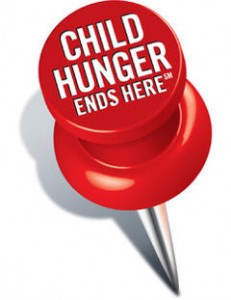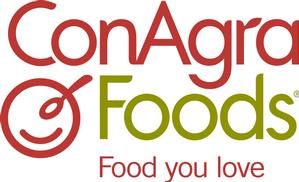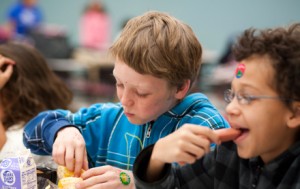Child Hunger Ends Here – Is it Real?
Child hunger is something that I have always been passionate about. I remember driving through downtown Los Angeles when I was younger and seeing a family with kids playing alongside the freeway under the overpass. I immediately empathized with those children who probably had little, if no food, that day. I wanted to reach out and help others, so I started volunteering with the church I was attending and handing out food on Skid Row. Now as an adult, and with children of my own, I couldn’t imagine my babies going without food. I am more than willing to promote the Child Hunger Ends Here Campaign with ConAgra Foods and Feeding America on The Mommy-Files. I believe that it is a worthy cause helping with a REAL issue in our country today!
CHILD HUNGER IN AMERICA
– In 2009, 17.2 million children under the age of 18 are living in food insecure households compared to 16.7 million in 2008.
– That means that nearly one in four children in the United States (23.2%) live in food insecure households.
– During the 2009 federal fiscal year, 19.5 million low-income children received free or reduced-price meals through the National School Lunch Program. Unfortunately, just 2.2 million of these same income-eligible children participated in the Summer Food Service Program that same year.
– In fiscal year 2009, 48 percent of all SNAP participants were children.
 – The breakdown of race/ethnicity for food insecure households with children is as follows:
– The breakdown of race/ethnicity for food insecure households with children is as follows:
– White, non Hispanic – 15.7%
– Black, non Hispanic – 32.6%
– Hispanic – 32.7%
– Other – 16.8%
– 20% or more of the child population in 30 states (and District of Columbia) are living in food insecure households.
– The states of Arkansas (28.5%), DC (27.2%) and Arizona (27.1%) have the highest rates of children in households without consisten access to food.
– The problem of child hunger is not simply a moral issue. Scientific evidence suggests that hungry children are less likely to become productive citizens.
– A child who is unequipped to learn because of hunger and poverty is more likely to be poor as an adult. As such, the existence of child hunger in the United States threatens future American prosperity.
– Research indicates that hungry children do more poorly in school and have lower academic achievement because they are not well prepared for school and cannot concentrate.
 Inadequate nutrition has adverse effects on:
Inadequate nutrition has adverse effects on:
– Physical Health: insufficient nutrition puts children at risk for illness and weakens their immune system.
– Behavioral and Mental Health: the lack of adequate nutrition affects the cognitive and behavioral development of children. Child development is the manner in which children attain skills in memory, cognition, language.
– Child Development: hunger puts children at developmental risk – characterized by slow or unusual development in areas such as speaking, behavior and movement.
– School Readiness and Achievement: children from food insecure households are likely to be behind in their academic development making it difficult for them to achieve the same level of academic achievement as their food-secure peers.
– 46% of the client households served by Feeding America food banks report having to choose between paying for food and paying for utilities or heating fuel.
– 40% of client households had to choose between paying for food and paying rent/mortgage.
– 34% of client households had to choose between paying for food and paying for medicine/medical care.
There are several federal programs focused on meeting the needs of low income and food insecure children and their families:
Supplemental Nutrition Assistance Program (SNAP)
-41% of Feeding America client households are receiving SNAP benefits
Special Supplemental Program for Women, Infants and Children (WIC)
– Among client households with children ages 0-3, 54% participate in WIC
National School Lunch Program (NSLP)
– Among client households with children under 18, 62% participate in the NSLP and 54% participate in the School Breakfast Program.
Summer Food Service Program (SFSP)
– Among client households with children under 18, 14% participate in NFSP.
Feeding America serves nearly 14 million children through its network of member food banks every year. 3 million of these children are aged 5 and under.
Breakdown of the age of the clients served by Feeding America network food banks is as follows:
– 0 to 5 years old (9%)
– 6 to 17 years old (29%)
– 18 to 64 years old (55%)
– 65+ (8%)
– 38% of clients are under age of 18.
– Feeding America addresses child hunger through two national programs.
Backpack Program
– Designed to meet the needs of food insecure children at times when other resources are not available, such as weekends and school vacations.
– Backpacks are filled with child-friendly, non perishable, easily consumed and vitamin fortified foods.
– Became an official national program of the Feeding America network in July 2006.
– More than 145 Feeding America members and partner distribution organizations operate more than 3,600 Backpack Programs and collectively serve more than 190,000 children each year.
Kid’s Cafe
– Provide free meals and snacks to low-income children through a variety of community locations where kids slready congregate – Boys & Girls Clubs, community centers, churches, etc.
– In 1993, Feeding America launched the national Kids Cafe program.
– There are currently more than 1,500 established Kids Cafes in operation.
– To learn more about how you can help, visit www.feedingamerica.org.
I am honored to be a Child Hunger Ends Here Blogger Correspondent. This is a topic that means a lot to me and I’m thankful for the opportunity to promote it on The Mommy-Files. This is a sponsored partnership with ConAgra Foods. All opinions expressed in this post are 100% mine.




















Thanks for sheeding light on this! Glad we have you as a blogger partner.
Dan Michel
Feeding America
Gosh, 1 in 4 households have kids that are hungry? How said! Thanks for putting this into perspective for us!